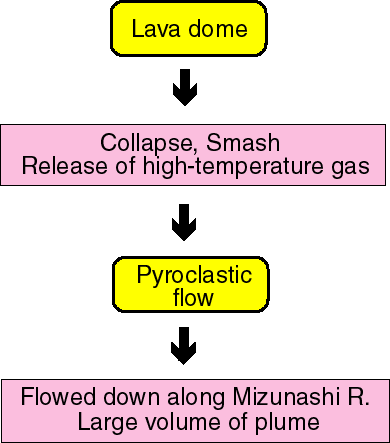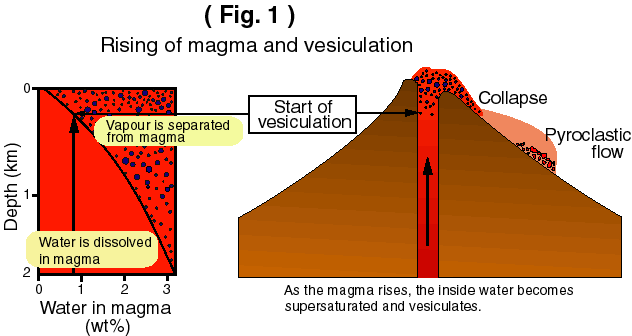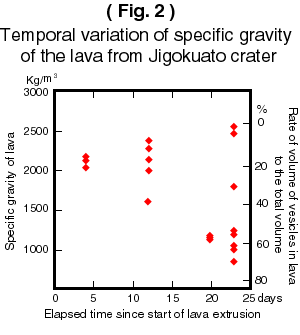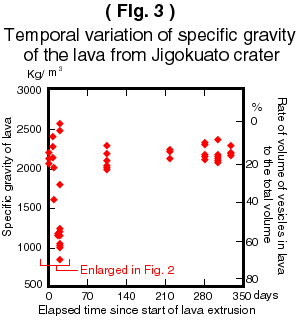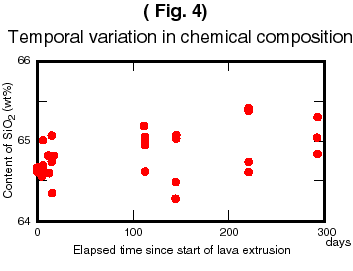 |
 Relation between Relation between
 the water content of the lava the water content of the lava
 and the feature of eruption and the feature of eruption

 In the case of the eruption of In the case of the eruption of
 Mt. Fugen, the water content Mt. Fugen, the water content
 of the lava is not so much of the lava is not so much
 (less than 1%). (less than 1%).
 Accordingly, Accordingly,
 the extruded lava the extruded lava
 made a dome on the top made a dome on the top
 of the mountain. of the mountain.

 If the water content If the water content
 had been much more, had been much more,
 the magma would have the magma would have
 vesiculated vesiculated
 to explode in a large scale to explode in a large scale
 like Mt. Pinatubo, the Philippines. like Mt. Pinatubo, the Philippines.

 The following figures, The following figures,
 Fig. 2 and Fig. 3, Fig. 2 and Fig. 3,
 show the change of show the change of
 the rate of vesicularity of lava the rate of vesicularity of lava
 extruded from extruded from
 the Jigokuato crater the Jigokuato crater
 with the elapsed time with the elapsed time
 since 20 May 1991. since 20 May 1991.
 As seen in Fig. 3, As seen in Fig. 3,
 the rate of content of vesicles the rate of content of vesicles
 in the lava was almost in the lava was almost
 constant on the average constant on the average
 (about 20% in volume) (about 20% in volume)
 during the whole period during the whole period
 of the eruption. of the eruption.

 However, only an exception However, only an exception
 was observed; namely, was observed; namely,
 there occurred a small scale there occurred a small scale
 of explosion on the 23rd day of explosion on the 23rd day
 after the start of after the start of
 the lava extrusion, the lava extrusion,
 11 Jun 1991. 11 Jun 1991.
 The cinder (bomb) erupted The cinder (bomb) erupted
 at that time was at that time was
 pumice whose pumice whose
 specific gravity was specific gravity was
 about 1000kg/m3 about 1000kg/m3
 and rate of vesicles and rate of vesicles
 reached 60% in volume (Fig. 2). reached 60% in volume (Fig. 2).
 This was only one case This was only one case
 of explosion. of explosion.

|

 Top of Part 3
Top of Part 3

 Previous p.
Previous p.

 Next page
Next page
 The pyroclastic flows
The pyroclastic flows
 in the 1990 - 1995 eruption
in the 1990 - 1995 eruption
 of Mt. Fugen
of Mt. Fugen
 were caused by the collapses of
were caused by the collapses of
 the lava domes.
the lava domes.

 The lava contained a lot of
The lava contained a lot of
 vesicles (vapour bubbles)
vesicles (vapour bubbles)
 and was quite fragile.
and was quite fragile.
 Hence
Hence
 the mixture of high-temperature
the mixture of high-temperature
 lava fragments,
lava fragments,
 volcanic ash and
volcanic ash and
 vapour
vapour
 flowed down at a very
flowed down at a very
 high speed along the Mizunashi River.
high speed along the Mizunashi River.

